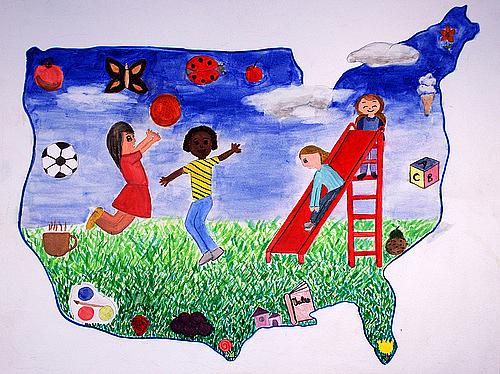States Get Bonus Bucks for Boosting Kid’s Health Coverage

Nearly two dozen states received a total of $307 million in bonus payments from the federal government this week for boosting enrollment numbers by making it easier for children to sign up for Medicaid and the Children’s Health Insurance Program (CHIP). The awards ranged from a Rocky Mountain high of $58 million in Colorado to a more modest $1 million in North Dakota.
So how did Maryland and Virginia close out the year by adding a combined $61 million to their coffers, while Maine and Tennessee walked away with zilch? As suggested by the term “performance bonuses,” the answer has to do with how well states did in increasing Medicaid enrollment of children over existing baselines. But eligible states also had to fulfill at least five of eight requirements designed to make it easier for kids to enroll in public health insurance and stay insured.
A little recent history may help here. CHIP was instituted in 1997 for the federal government to help states provide insurance for children caught between Medicaid ineligibility and not being able to afford private health insurance. The program, reauthorized in 2009 to extend health insurance to millions of low-income children, also set up a system of bonuses for states that took steps to increase the ranks of children enrolled in CHIP and Medicaid. The bonuses were to continue for five years, meaning this year’s marks the last of the awards.
Under the program, states were offered financial incentives to enact changes including:
- Eliminate the face-to-face interview requirement for Medicaid or CHIP applications and renewals.
- Use the same or interchangeable forms for Medicaid and CHIP applications and renewals.
- Practice “presumptive eligibility” for Medicaid and CHIP -- if a child appears eligible, allow the child to enroll while the official determination pends.
- Get rid of or ease the burden of proof on “asset tests,” which look at a family’s assets to determine a child’s eligibility.
South Carolina, awarded $17.5 million this year, took advantage of what’s called “Express Lane Eligibility,” according to the The Post and Courier, “which allows the South Carolina Medicaid agency to cull information from the Department of Social Services to determine if children qualify for a health plan. Children whose families are determined eligible for food stamps or welfare payments can now be automatically enrolled in Medicaid.”
The common thread here is to make it easier for low-income families to get their kids on public insurance. If states could check-off at least five of eight such requirements, they were eligible for federal dollars (intended to both encourage reforms and defray the costs of insuring added kids). Then, the more children enrolled in Medicaid or CHIP, the more money the state gets. New Jersey enrolled many more children (about $22.5 million in bonus funds), Michigan fewer ($1.6 million).
“States are working hard to ensure children get access to the health coverage they need,” CMS Administrator Marilyn Tavenner said in announcing this year’s awards. “We are pleased to provide financial support to reward states that are reducing enrollment barriers and are connecting kids to coverage.
Overall, the percentage of children participating in Medicaid and CHIP programs has increased in recent years, according to an Urban Institute analysis. In 2007, about 82% of eligible children were enrolled, while in 2011, more than 87% were enrolled.
As of 2010, Medicaid and CHIP covered one-third of children in the United States. The two programs covered more than 56% of black and Hispanic children. An estimated 7.5% of U.S. children remained uninsured as of 2011.
While 2013 marked the last year of the federal bonus program, the enrollment simplifications pushed over the last five years via incentives will now become standardized in all states’ Medicaid, CHIP and marketplace programs in 2014, according to CMS.
Image by Korean Resource Center via Flickr

